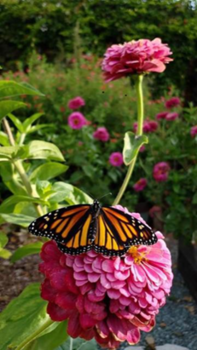
Butterflies are attracted to red, orange, yellow and purple flowers, but they need more than just plants to survive. All their needs can be satisfied in a small corner of any garden.p Our Monarchs by Planting Milkweed and Flowers!
Last Thanksgiving, only 28,429 monarchs were counted in their wintering colonies compared to a historic population of about 10 million in the Western Monarch Migration. Today’s monarchs face several challenges, the most intractable being a lack of Milkweed (Asclepias spp.), where females typically lay their eggs, as well as a lack of winter blooming nectar plants to feed them along their journey. They are also being decimated by the increased use of glyphosate in agriculture, which kills milkweed and other sources of food for these butterflies.
If you have a sunny, open 4′ x 4′ space where you could plant milkweed and butterfly flowers – you could be part of the solution!
At this special workshop we talked about how to plant and maintain a butterfly garden, then we planted California native milkweed (and other flower seeds) to create our own butterfly gardens. Participants left with milkweed, winter blooming flowers and information on how to help the monarchs!
Thank you to everyone who participated on Saturday July 20, 2019 and good luck with your germination!
NOTE: Many nurseries sell milkweed plants that have been treated with neonicotinoids (this link is about bees, but you get the picture). Please be sure to ask if plants have been treated before you buy them. Ploughshares Nurseries does not use neonicotinoids on their plants.
Here is a copy of the PDF handout on
Cool Season Nectar Plants for Western Monarch Butterflies.
Here is a copy of Birgitt Evan’s presentation (PDF) on
Saving the Western Monarch
The Xerces Society offers lots of information on protecting our pollinators.
Enjoy the slideshow from this popular special event:
- Alameda Backyard Growers special event on saving monarchs
- About 50 people attended this event
- Nina helps with monarch presentation
- Birgitt discusses ways to help save the Western Monarch
- Milkweed seed planting
- Milkweed and other beneficial plants donated
- In line to get seeds and dirt







